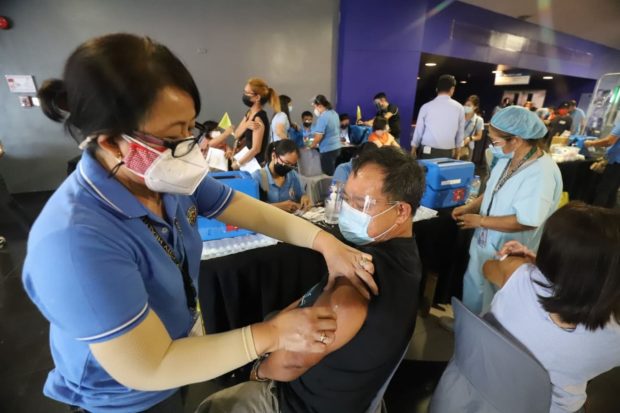
RUSH JAB The Iloilo City government ramps up its vaccination of elderly residents and those with medical conditions at a vaccination center at SM City Iloilo amid a renewed surge in COVID-19 cases. —PHOTO COURTESY OF OFFICE OF THE ILOILO CITY MAYOR
MANILA, Philippines — The Philippine government should aim to vaccinate 50 percent of the population in Metro Manila and six other areas considered “high risk” for COVID-19 to achieve herd containment, the OCTA Research group said Monday.
In a report, 50% of the population in Metro Manila and cities Tuguegarao, Santiago, Baguio, Cainta, Cebu and Imus should be vaccinated due to their high number of COVID-19 cases.
This translates to 7.98 million people and would require 15.96 million doses, the group said.
“In many countries that have vaccinated 50% of the population, there has been an immediate impact on herd containment of COVID-19. This is the immediate target in high risk areas,” Octa said.
For moderate-high risk areas, 40% of the population should be vaccinated, while moderate risk areas will need to vaccinate 30% of its population to achieve herd containment.
This will require 7.3 million doses for moderate-high risk areas and 3.08 million doses for moderate risk areas, Octa said.
“A rollout of 30 to 35 million vaccines before the end of 2021, allocated by risk level, will help the country recover before the end of 2021,” the group added.
Octa pointed out that Metro Manila, Calabarzon, Central Luzon, Central Visayas, and Western Visayas accounted for 80% of new COVID-19 cases reported in 2021.
The said regions also suffered the highest gross regional domestic product loss in 2020, the group said, which accounts for 82% of the country’s economic losses for the said year.
Octa said allocation of vaccines by region should start with a similar structure, where 40 to 45% of the vaccines going to Metro Manila, 15 to 20% to Calabarzon, 10% to Central Luzon, 6% to Central Visayas, and 4% to Western Visayas.
The rest would be then given to the rest of the country, with priority given to areas with the highest risk levels, Octa said.
“A national rollout program based solely on population, regardless of risk levels of each province or LGU, will delay pandemic and economic recovery in the country due to global supply chain issues. The country cannot afford to wait another year to reach herd immunity,” the group said.